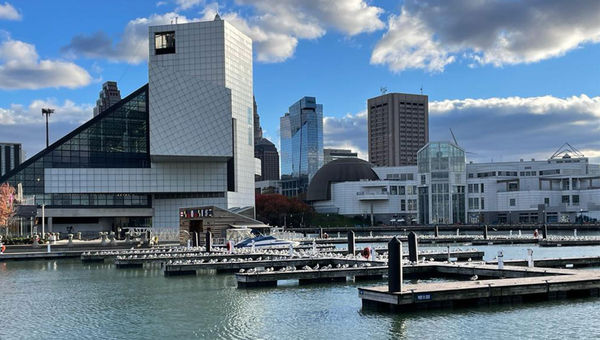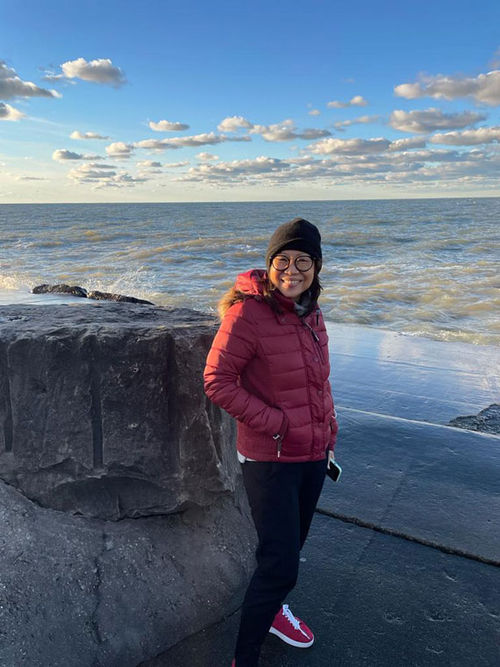
Yeoh Siew Hoon
Call it revenge travel, pent-up demand or making up for lost travel; whatever it is, I have never spent as much time as I did in the U.S. this trip, and to finish it off, I decided to go off the beaten track to Ohio.
Ohio? I hear you ask. Ohio! I hear you exclaim. Why? That was the response I got from almost every American friend (or stranger) when I told them where I was off to after New York, Miami and Fort Lauderdale.
I know. Ohio may not have been the most obvious destination for a first holiday in 20 months for someone from Singapore, but it certainly yielded the most unexpected discoveries. And perhaps this could be the way post-pandemic travel eventually pans out, that we seek out the not-so-obvious to truly enjoy the serendipity and anonymity of travel.
On the United Airlines flight from Fort Lauderdale to Cleveland's Hopkins Airport, I am pretty sure I am the only tourist from Asia headed for this Midwestern state where I've been told it is "very cold," "there's not much to do there" and "you'll get bored after one day."
Expectations managed, I settle in for the two-and-a-half-hour flight, masked and as distanced as possible from the passenger next to me.
It's a pretty sold-out flight, marking the beginning of Thanksgiving travel season, and by this, my second domestic flight in the U.S., I am getting used to the new protocols of flying. Mask on in airport and on flight, and that's about all that's changed. The experience of travelling in America is pretty much as I remember pre-pandemic: crowds, queues, security officers instructing you "shoes off, jackets off, belts off, nothing larger than your mobile phone in your bags."
Everything is supersize here. Hopkins Airport, which used to be one of the hubs of Continental Airlines, is huge, and you have to walk for miles to get from aircraft to baggage. Outside, the weather is definitely chillier than in Florida: in under three hours, I've gone from being barefoot on sandy beaches to boots in snow.
OK, so maybe not snow. Apparently, there was snow just two days before I arrived, and there will be snow right after I leave. Like the stealth traveler I am, I have sneaked in between snowfalls. This is part of what is called the Rust and Snow Belt of the U.S. -- rust because of the industrial decline of cities in this region in the '80s and '90s and snow because of its location on Lake Erie.

The Rock & Roll Hall of Fame is on Lake Erie. Photo Credit: Yeoh Siew Hoon
The lake view from the Rock & Roll Hall of Fame
Snow or no snow, there's a distinct chill in the air, colder than New York was, and when the winds blow over the lake as you take a walk outside the Rock & Roll Hall of Fame, even the seagulls take flight, flapping their wings vigorously; I presume it's to keep warm.
Once inside, I feel like breaking out in song and dance as I walk through the Hall, celebrating the lives and works of men and women who have brought so much joy into our lives through their music. There's a Tom Petty exhibit, and on display are his lyrics to "Wildflowers," among other memorabilia and milestones in his relatively short life.
As you walk through the halls, which trace the history of rock 'n' roll, you feel like you're reliving your own life: the moment when you first fell in love with a song, the moment when you first fell in love with someone, your first break-up, your first kiss ... .
Music provides the soundtrack to our lives, and this institution, founded on April 20, 1983, by Ahmet Ertegun, founder and chairman of Atlantic Records, is a wonderful place to spend a few hours, soaking in the music and if you feel like it, you can jam in the studio -- although with Covid in the air, it is distinctly underused right now.
I guess no one wants to be touching anything unnecessarily. Covid cases are high, and vaccination rates relatively low in this part of the country. In indoor places, masks are mandatory.
Checking out Cleveland

The author, by the shores of Lake Erie. Photo Credit: Courtesy of Yeoh Siew Hoon
What I like about Cleveland is how spread out and low-rise it is, with only a handful of skyscrapers jutting out into the big blue, wintry sky. After New York and Miami, I appreciate the distinctly small-town feel to this city. It's quiet, laid-back, perfect for those seeking a slower pace of travel.
I visit an area called the Flats, a redeveloped area on the banks of the Cuyahoga River, known for its happening nightlife. But at this time of the year, on a Thursday evening, not much was happening. You can also catch live theater at Playhouse Square and as one of Broadway's premier touring partners, the theaters here do get a good variety of plays, musicals and concerts -- minus the crowds in New York.
For dinner, we try out the Flying Fig, which is tapping into the global farm-to-table trend. Its menu lists the farms from which it gets its produce. Its food is fusion-like: I have shrimp on a skewer with garlic aioli and pan-seared trout with red curry sauce and rice. Mix of Spanish and Thai in Ohio -- isn't that why we travel?
Leaving the city
For nature, you can immerse yourself in Cuyahoga Valley National Park. The winding Cuyahoga River gives way to deep forests, rolling hills and open farmlands. Just wrap up warm for winter walks and all that fresh air and nature should blow all your worries away.
Beyond the big city of Cleveland, there are the small towns to explore, and at each -- whether it be Hudson or Marysville or someplace else -- I felt all the novels I had read by authors such as Anne Tyler and Wally Lamb come alive. Celeste Ng's "Little Fires Everywhere" is based in Shaker Heights, Ohio, right outside Cleveland. Ng lived there from 1990 to 1998.
At Marysville, I visit the global headquarters of Honda, just to appreciate the impact such a company can have on a local community. It's massive, almost a city unto itself, and I am told it is responsible for more than 14,000 jobs in the area. This is where the automotive giant does its research and development, and testing, to create the future of cars.
Even as it embraces progress, this is a town that also cares for its heritage. In the town, community leaders have taken it upon themselves to save and restore the town's historic Avalon Theatre, which was built in 1936 and was the focal point for arts and culture until it closed its doors in 2009 and fell into disrepair. Today, a $3.2 million restoration project is underway to revitalize the cultural landmark.
Ohio is also home to the largest Amish population in the U.S., about 60,000, and I had been looking forward to having pie in Plain City, it being the most touristy thing one can do there. However, it being a Sunday, that activity was off the table. I did end up having the best homemade apple pie I've ever had in a friend's home -- and that's the charm of Ohio, from its big, small city of Cleveland to its small towns.
They are big in heart, heritage, hospitality and rock 'n' roll.